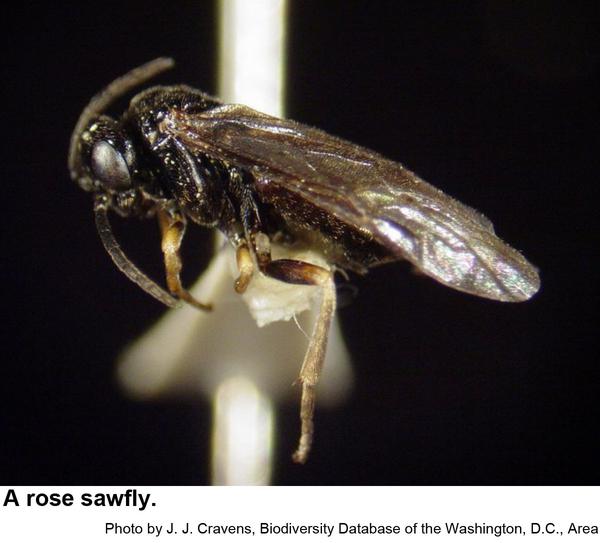Description and Biology
Roseslug caterpillars, Endelomyia aethiops, are also called common roseslugs and American roseslugs. They are called "slug-" caterpillars because their prolegs lack tiny hooks most of the moth and butterfly caterpillars have. Because their prolegs are so short and they have a slimy covering, these caterpillars do resemble slugs. Roseslugs are yellow-green with an orange head and grow to about ¾ inches long as they feed on undersides of leaves. Roseslugs are the immature stage of a small, very dark, flylike insects that use a sawlike ovipositor to pierce leaves as they lay eggs inside. Rose sawflies are actually thick-waisted, primitive wasps that emerge in early spring to lay eggs. Eggs hatch and larvae emerge in late April to early May. Mature roseslugs crawl to the ground to spin cocoons by mid June. New rose sawflies emerge from the cocoons the following year. We have one generation of roseslugs each year.
Host Plants
Roseslugs skeletonize the leaves of wild and cultivated rose, leaving the veins intact. Damage typically first appears in early to mid-May and can continue through mid-June. Infested leaves eventually turn brown and dry up. Damage caused by roseslugs is cosmetic but can make infested shrubs look terrible.
Residential Recommendations
Early detection of roseslug damage is important because early detection allows a wider range of control options. Small numbers of roseslugs can be removed by hand. Roseslugs should be susceptible to pesticides labeled for roses in residential landscapes. The University of Maryland suggests horticultural oils or spinosad for roseslugs. Oils are virtually harmless to mammals unless inhaled. Oils are toxic to spider mites as well (and predaceous mites, too). In general, soaps and oils are less damaging to beneficial insects than most other insecticides. Spinosad is also relatively safe for mammals, but deadly to caterpillars and some other pests (but not spider mites). The Missouri Botanical Garden lists soaps, oils, neem, and some synthetic insecticides for rose slug control. Their article also says that Bacillus thuringiensis is NOT effective. Read and follow all label instructions of the insecticide that you select to ensure that the product is used in the safest and most effective manner possible.
Other Resources
- Horticultural Oils for Ornamental Plants. Frank, Steven. 2018. NC State Extension Publications.
- Pearslug. Baker, J. R. 2019 (revised). NC State Extension Publications.
- Rose and pear slugs (sawflies). Anonymous, No Date. Missouri Botanical Garden.
- Rose Insects & Related Pests. Scott, J. M, and J. Williamson. 2019. Clemson Cooperative Extension Home & Garden Informantion Center Factsheet HGIC 2107.
- Roseslug. Rosetta, R. L. 2016. Pacific Northwest Nursery IPM, Insects.
- The Rose Slugs. Chittenden, F. H. 1908. Circular No. 105. United States Department of Agriculture, Bureau of Entomology.
- NC State Extension Plant Pathology Publications
- NC State Horticultural Science Publications
- North Carolina Agricultural Chemicals Manual
For assistance with a specific problem, contact your local Cooperative Extension center.
This factsheet has not been peer reviewed.
Publication date: May 29, 2020
Revised: May 22, 2021
Recommendations for the use of agricultural chemicals are included in this publication as a convenience to the reader. The use of brand names and any mention or listing of commercial products or services in this publication does not imply endorsement by NC State University or N.C. A&T State University nor discrimination against similar products or services not mentioned. Individuals who use agricultural chemicals are responsible for ensuring that the intended use complies with current regulations and conforms to the product label. Be sure to obtain current information about usage regulations and examine a current product label before applying any chemical. For assistance, contact your local N.C. Cooperative Extension county center.
N.C. Cooperative Extension prohibits discrimination and harassment regardless of age, color, disability, family and marital status, gender identity, national origin, political beliefs, race, religion, sex (including pregnancy), sexual orientation and veteran status.



